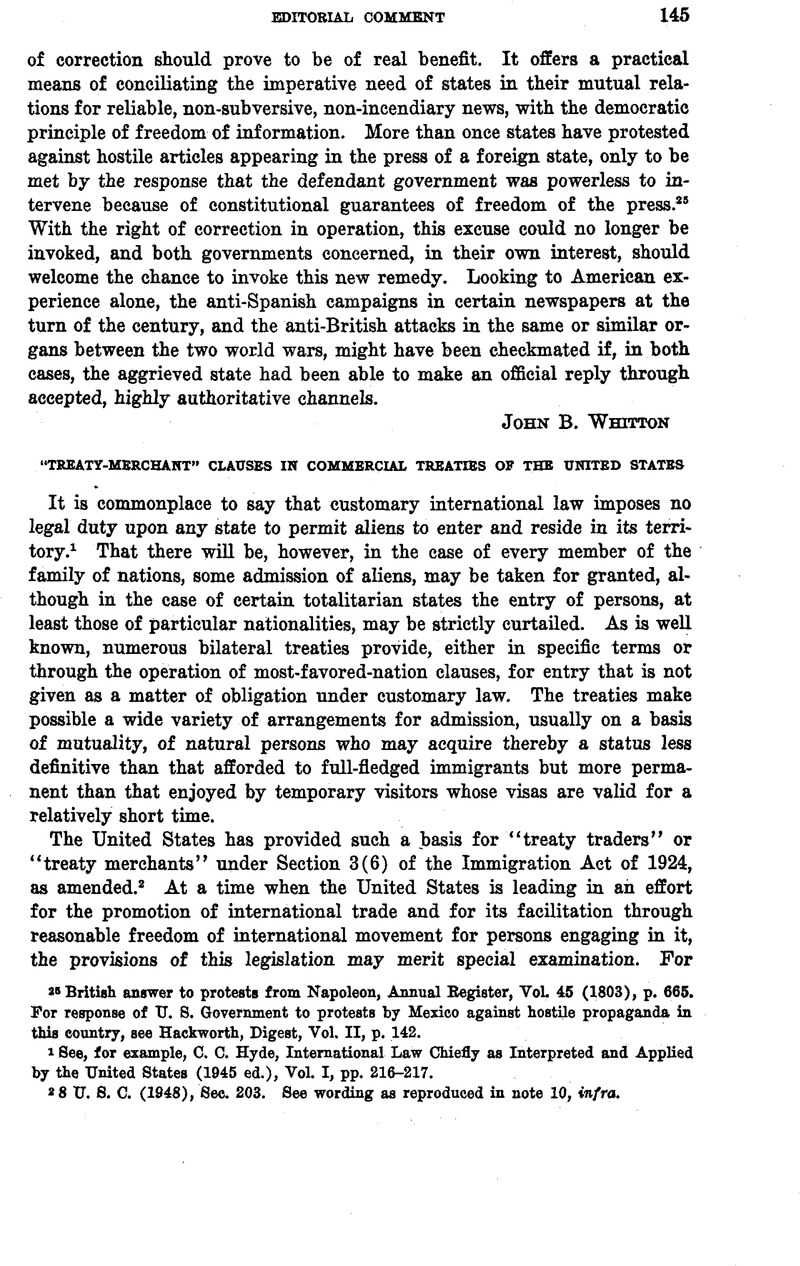No CrossRef data available.
Published online by Cambridge University Press: 20 April 2017

1 See, for example, Hyde, C. C., International Law Chiefly as Interpreted and Applied by the United States (1945 ed.), Vol. I, pp. 216–217 Google Scholar.
2 8 U. S. C. (1948), Sec. 203. See wording as reproduced in note 10, infra.
3 65 Cong. Rec. 5811 (letter from Secretary of State Hughes to Representative Albert Johnson). The letter stated that Sec. 3(2) of the proposed bill, under which non-immigrant status could be given to aliens entering temporarily for business or pleasure, would not meet the treaty requirements.
4 Ibid., p. 6315.
5 Senator Shortridge said that the so-called understanding of 1907 had failed of its purpose and had ceased to be operative (Ibid., p. 6303).
6 H. Rept. No. 350, 68th Cong., 1st Sess., p. 2.
7 65 Cong. Rec. 6304.
8 U. S. Foreign Relations, 1927, Vol. I, p. 439.
9 75 Cong. Rec. 13841.
10 “…an alien entitled to enter the United States solely to carry on trade between the United States and the foreign state of which he is a national, under and in pursuance of the provisions of a treaty of commerce and navigation, and his wife and his unmarried children under twenty-one years of age, if accompanying or following to join him.”
11 That the Department of State had taken this construction as the proper one even under the earlier wording of the statute is indicated by a communication on the point from the Department of State to the Department of Labor on Jan. 24, 1925 ( Hackworth, , Digest, Vol. III, pp. 769–770)Google Scholar.
12 There was some debate on the question of excluding from the benefits of the section children adopted since 1924. A proposal to change the language by insertion of the words “including legally adopted children” was defeated in the Senate. 75 Cong. Rec. 13423.
13 75 Cong. Rec. 13841. See also, on the point, House Bept. No. 431, 72nd Cong., 1st Sess.
14 The Department of State took this position in 1929 (despite the apparently contrary decision of a Federal court, four years earlier, in the case of Weedin v. Wong Tat Hing et al., 6 Fed. (2nd) 201), “in order to keep faith with Congress and to carry out what was evidently the intent of Congress when it passed the Act.” Hackworth, , Digest, Vol. III, pp. 766–767 Google Scholar.
15 Irving, Appleman, “Treaty Trader Status under the Immigration Laws,” Department of Justice, Immigration and Naturalization Service, Monthly Beview, Vol. VI, No. 1 (July, 1948), pp. 3, 5Google Scholar.
16 Idem.
17 22 C. F. E. 61.140 (d), cited by Applemali, loc. cit., p. 4.
18 Hackworth, , Digest, Vol. III, p. 767.Google Scholar
19 Appleman, loc. cit., pp. 5, 6.
20 Hackworth, op. cit., Vol. III, pp. 771, 772.
21 New York Times, March 27, 1948, p. 12. A bill (H. B. 3566) was then before Congress to effect a stay of deportation for some two thousand persons who were reported to have become subject to deportation with the termination of the treaty.
22 44 Stat. 2132.
23 48 Stat. 1507.
24 The treaty with Poland refers to nationals of one party “entering, traveling or residing in the territory of the other Party in, order to carry on international trade or to engage in any activity related to or connected with the conduct of international trade….” More recent treaties, e.g., that signed with China on Nov. 4, 1946 (Department of State, Treaties and Other International Acts Series, No. 1871, this Journal, Supp., Vol. 43 (1949), p. 27, and that signed with Italy on Feb. 2, 1948 (S. Ex. E, 80th Cong., 2nd Sess.), when referring to nationals of one party entering, traveling and residing in the territories of the other, specifically mention the two countries as those between whose territories the international trade, or “commercial activity related thereto or connected therewith” is to be carried on.
25 For the statistics (with classification by years and by countries), the writer is indebted to the U. S. Bureau of Immigration and Naturalization.
26 For recently promulgated regulations applicable to the subject matter, see Fed. Reg., Vol. 14, No. 184 (Sept. 23, 1949), p. 5805.
27 See this writer’s article, “Postwar Commercial Treaties of the United States,” in this Journal, Vol. 43 (1949), pp. 262, 264 note.